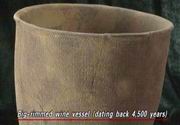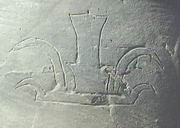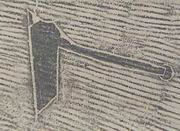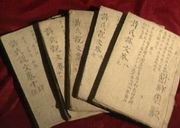 |
|
Ancient Inscriptions on Pottery |
| CCTV.COM 2003-09-03 14:09:35 |
|
 At dusk one day in 1979, an archaeologist in Juxian County, Shandong Province washed his hands by a river. Suddenly he found a dark grey potsherd tilting in the river. Because he was professionally sensitive, he pulled out the potsherd and discovered an important cultural site of remote antiquity. At dusk one day in 1979, an archaeologist in Juxian County, Shandong Province washed his hands by a river. Suddenly he found a dark grey potsherd tilting in the river. Because he was professionally sensitive, he pulled out the potsherd and discovered an important cultural site of remote antiquity.
The cultural site was named after the Lingyang River where over 2,000 cultural relics were excavated. These cultural relics date back 4,000 years. The most precious were the big-rimmed wine vessels, sacrificial vessels of the Dawenkou Culture. The upper part of each vessel was carved with picture symbols. In the academic circles, such symbols are known as inscriptions on pottery. The inscriptions, plus those that had been discovered in the area earlier, totaled 20. They provided rare figurative data for the study of the origin of the ancient Chinese written language.
“The development of the written language went through a transition stage and an embryo stage. Many scholars probably share our view. The embryo stage was the predecessor of the written language,” said Su Zhaoqing, research fellow of Juxian County Museum, Shandong Province.
 The written Chinese language originated from the pictograph in ancient times. Xu Shen, a scholar of the Eastern Han Dynasty in the first century, wrote about this in his book “An Analytical Dictionary of Chinese Characters”. He noted that people in remote antiquity looked up at the heavenly bodies, looked down at the earth and observed the traces of beasts, insects and birds before they created the Chinese characters. The written Chinese language originated from the pictograph in ancient times. Xu Shen, a scholar of the Eastern Han Dynasty in the first century, wrote about this in his book “An Analytical Dictionary of Chinese Characters”. He noted that people in remote antiquity looked up at the heavenly bodies, looked down at the earth and observed the traces of beasts, insects and birds before they created the Chinese characters.
The oracle bone inscriptions of the Yin and Shang Dynasty dating back more than 3,000 years were discovered at the beginning of the 20th century. They were the earliest Chinese characters discovered so far. But the oracle bone inscriptions were a mature system of written language. There was certainly a period of development of the written language before the creation of the oracle bone inscriptions in China.
The inscriptions on pottery discovered at the Lingyang River site of Juxian County, Shandong Province were neatly done. Many scholars maintain that they had explicit phonetic and semantic functions and served as the primitive written language in ancient China. For instance, this symbol figuratively marked a big axe with a shaft. Scholars believe it signifies the present-day character “yue” which means “an ancient battle-axe”. The shape of the unearthed jade battle-axe dating back to the same period is quite close to the pottery script.
 Another pottery symbol refers to the sun rising from the east mountains. Experts believe that this is “dan” which means “dawn”. They explain the symbol from the angles of astronomy and folklore. Another pottery symbol refers to the sun rising from the east mountains. Experts believe that this is “dan” which means “dawn”. They explain the symbol from the angles of astronomy and folklore.
“The symbol means “dan”, that is, “dawn” when the sun rises from the ountains. I investigated there 10 times. At the Spring Equinox and the Autumn Equinox, I stood at the site where the pottery inscriptions had been unearthed. I looked towards the east. The sun rose from the Wulougu Mountain in the due east direction. The image was quite close to the inscription,” said Su Zhaoqing.
“I think the ancients in Juxian needed this for navigation and farming. After observing the sun for a long time, they discovered the mystery of the Spring Equinox and Autumn Equinox. I think this inscription portrayed how the Dongyi nationality and the ancients in Juxian worshipped the sun,” said Su Zhaoqing.
 Since the 20th century, besides the pottery inscriptions in Juxian County, Shandong Province, Chinese archaeologists have discovered figurative symbols carved on pottery, jade and bones in the Yellow River and Yangtze River valleys. They date back to remote antiquity. This proves that the written Chinese language has existed for at least about 5,000 years. The ancient pottery inscriptions found from the site of the Lingyang River are an embryo of the Chinese characters that are still in use today. Since the 20th century, besides the pottery inscriptions in Juxian County, Shandong Province, Chinese archaeologists have discovered figurative symbols carved on pottery, jade and bones in the Yellow River and Yangtze River valleys. They date back to remote antiquity. This proves that the written Chinese language has existed for at least about 5,000 years. The ancient pottery inscriptions found from the site of the Lingyang River are an embryo of the Chinese characters that are still in use today.
|
|
Editor: Han Ling CCTV.com
|
|
|
|
|
|
 |









